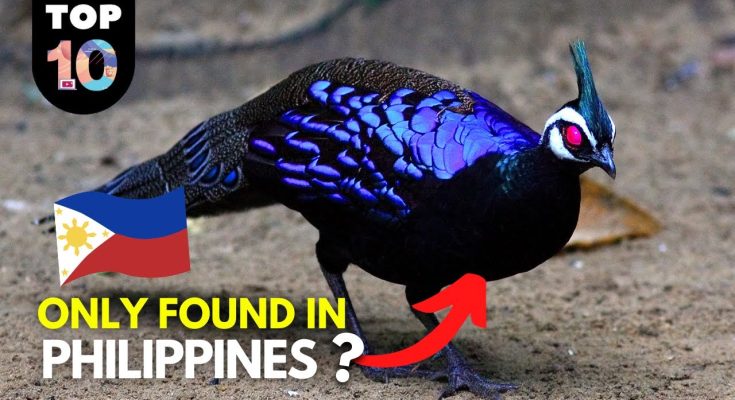The Philippines, a biodiversity hotspot, is home to many rare and endemic species. Due to its unique island ecosystems, many animals here are found nowhere else on Earth. Let’s explore 10 of the rarest animals only found in the Philippines.
### 1. **Philippine Eagle (Pithecophaga jefferyi)**
The Philippine Eagle, also known as the Monkey-eating Eagle, is one of the largest and most powerful birds of prey in the world. With a wingspan that can reach over 7 feet (2.1 meters), this apex predator feeds on monkeys, flying lemurs, snakes, and other small mammals. It lives in tropical rainforests and is critically endangered, with fewer than 400 individuals left in the wild due to deforestation and habitat loss. As the national bird of the Philippines, it represents both the beauty and fragility of the country’s wildlife. Conservation efforts are in place to protect these majestic raptors, but they remain on the brink of extinction.
### 2. **Tamaraw (Bubalus mindorensis)**
The Tamaraw is a small, dark-haired buffalo native to the island of Mindoro. It’s smaller than the water buffalo (carabao), with shorter, stockier horns. Tamaraws once roamed much of the island but are now critically endangered, with fewer than 600 individuals left due to habitat destruction, hunting, and disease. Found primarily in grasslands and forested areas of Mindoro, the Tamaraw is a symbol of the country’s conservation struggles. Intensive efforts to preserve and breed these rare animals have been ongoing, but their future remains uncertain.
### 3. **Philippine Tarsier (Carlito syrichta)**
One of the smallest primates in the world, the Philippine Tarsier is a nocturnal creature with distinctively large eyes, perfect for its nighttime hunting in dense forests. These tarsiers are native to several islands, including Bohol, Leyte, Samar, and Mindanao. They are insectivorous and can leap from tree to tree in their forested habitat. Although they are a popular tourist attraction, their populations are dwindling due to habitat destruction, illegal pet trade, and other threats. Conservation groups are working to protect them, but they remain vulnerable.
### 4. **Philippine Crocodile (Crocodylus mindorensis)**
The Philippine Crocodile is one of the most endangered crocodilian species in the world. Unlike its larger cousin, the saltwater crocodile, this species is relatively small, growing to about 3 meters (10 feet) in length. It is only found in freshwater environments such as rivers, marshes, and lakes in Luzon and Mindanao. Due to habitat destruction and illegal hunting, the Philippine Crocodile’s population has dropped significantly, and it is now critically endangered. Conservation programs are underway, but illegal activities still pose a major threat.
### 5. **Philippine Spotted Deer (Rusa alfredi)**
This rare and critically endangered deer is only found in the rainforests of the Visayan Islands, particularly in Panay and Negros. The Philippine Spotted Deer is smaller than other deer species and is easily recognizable by its distinctive white spots on its dark brown coat. The primary threats to its survival are habitat destruction and hunting. Conservation efforts, including breeding programs, are being implemented to save this species from extinction, but its population continues to decline.
### 6. **Palawan Peacock-Pheasant (Polyplectron napoleonis)**
The Palawan Peacock-Pheasant, a small bird with iridescent blue-green feathers, is endemic to Palawan. Males are particularly striking, with vibrant tail feathers that they fan out during courtship displays. This species is vulnerable to habitat destruction due to logging and land conversion. Although the bird is protected under Philippine law, illegal hunting and capture for the pet trade continue to threaten its survival.
### 7. **Visayan Warty Pig (Sus cebifrons)**
This critically endangered species of wild pig is native to the Visayan Islands of the Philippines. The Visayan Warty Pig is distinguished by its warty face and dark mane, which becomes more pronounced in males during mating season. It inhabits forested areas and is mainly threatened by habitat loss and hunting. The Visayan Warty Pig is one of the rarest wild pigs in the world, and its numbers are declining despite conservation efforts.
### 8. **Philippine Flying Lemur (Cynocephalus volans)**
Despite its name, the Philippine Flying Lemur, or Colugo, is not a lemur and does not actually fly. It glides from tree to tree using a membrane of skin that stretches from its neck to its limbs. It is a nocturnal animal and primarily feeds on leaves, fruits, and flowers. This species is native to the forests of Mindanao, Bohol, and nearby islands. While not yet endangered, it faces threats from deforestation and habitat fragmentation, which could lead to population declines.
### 9. **Philippine Sailfin Lizard (Hydrosaurus pustulatus)**
The Philippine Sailfin Lizard is a large, semi-aquatic lizard known for the sail-like crest on its back and tail. It is found in rivers and streams in tropical forests, particularly in Luzon and the Visayas. This lizard is an excellent swimmer and can even run across water on its hind legs. While it is not currently endangered, its habitat is under threat from deforestation and land development, and it is often captured for the pet trade.
### 10. **Rafflesia (Rafflesia philippensis)**
Although not an animal, the Rafflesia plant deserves mention due to its rarity and bizarre characteristics. This parasitic plant is known for producing the largest flower in the world, which can reach up to 3 feet (1 meter) in diameter. Rafflesia is found in the forests of Luzon and Mindanao. The flower emits a strong odor similar to that of rotting flesh, which attracts carrion flies that pollinate the plant. Despite its unusual beauty, the Rafflesia is threatened by habitat destruction and is considered endangered.
### The Challenge of Conservation in the Philippines
The Philippines is one of the most biologically diverse countries in the world, but it also has one of the highest rates of biodiversity loss. Many of the animals mentioned above are critically endangered due to a combination of factors, including habitat destruction, deforestation, illegal hunting, and the illegal wildlife trade. Conservation efforts are in place, but these programs face significant challenges due to limited resources, political issues, and the widespread poverty that can drive people to poach or destroy habitats for agricultural purposes.
Protected areas and breeding programs are essential for the survival of these species, but more needs to be done to ensure their future. Public awareness and education are also critical components of conservation efforts, as many Filipinos are unaware of the unique wildlife found in their country or the threats these animals face. Additionally, stricter enforcement of wildlife protection laws and collaboration with local communities to create sustainable livelihoods can help reduce the pressures on these species and their habitats.
Despite these challenges, the future of conservation in the Philippines holds promise. Organizations such as the Philippine Eagle Foundation, Talarak Foundation, and many others are working tirelessly to protect the country’s wildlife. With continued effort, collaboration, and a growing global awareness of biodiversity’s importance, there is hope that these rare animals and their ecosystems will be preserved for future generations.
### Conclusion
The rare and unique animals of the Philippines are not only a testament to the country’s natural beauty but also a reminder of the urgent need for conservation. These species, from the majestic Philippine Eagle to the enigmatic Philippine Tarsier, are integral to the ecological balance of the archipelago. Protecting these animals is not just about saving individual species; it’s about preserving the complex ecosystems that support life on Earth.
The Philippines’ rich biodiversity is a treasure, but it is a fragile one. With growing threats from human activity, immediate action is necessary to safeguard these rare animals and their habitats.



